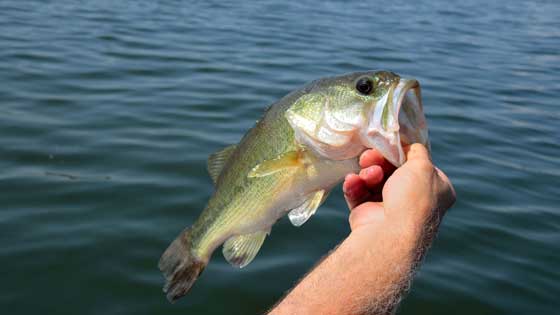Largemouth Bass Facts

A 6lb Largemouth in the north is considered a trophy bass, while a 12lb plus Largemouth Bass is considered a trophy fish in Florida.
Introduction
Largemouth Bass fishing is a favorite with us. It’s also the most popular game fish in North America and found abundantly in lakes and feeder streams and rivers in both Canada and the United States.
The Largemouth Bass (Micropterus salmoides), is commonly known to anglers as the black bass, bigmouth, green bass, green trout, Florida bass, Oswego bass, the southern largemouth and most affectionately as old bucketmouth.
Not all of these names are accurate as other species use the same name Black Bass. Scientifically speaking, there are 7 species that are a members of the Micropterus family.
- M. cataractae – Shoal Bass
- M. coosae – Redeye Bass
- M. dolomieu – Smallmouth Bass
- M. notius – Suwannee Bass
- M. punctulatus – Spotted Bass
- M. salmoides – Largemouth Bass
- M. treculii – Guadalupe Bass
Tourism
Anglers all over North America love the Largemouth for the incredible fight and explosive strikes that it provides at the end of a line. Full out-of-water leaps give the largemouth bass it’s incredible reputation. If you’ve never fished for largemouth, we recommend giving it a try.
The Largemouth bass tops the Bass Fishing Gurus list of game fish with salmon being a close second, but more on that later.
This species is responsible for a large tourism industry in both Canada and the United States as well as many other countries where the Largemouth has been introduced.
The largemouth bass provides significant amount of revenue to the television market in the form of tournaments and various fishing television shows. The revenue generated from this fish alone is estimated to be in the billions.
In Florida alone, Largemouth Bass fishing generates about $3.4 billion annually. This includes the Florida Largemouth variety, which is a close cousin.
Growth
Rapid growth of the Largemouth Bass depends largely on
- environment
- availability of food
- predators
- water temperature
Water temperature is the single biggest factor in their growth rates. This is especially evident when we look at the size of largemouth in the north.
A 6lb largemouth in the north is considered a trophy bass while a 12lb plus largemouth bass is considered a trophy fish in Florida. In Florida they can grow a massive to 18lbs.
Where you’ll find Largemouth Bass
These fish are found in marshes, swamps, ponds, reservoirs, creeks, large rivers and lakes, which provides them a huge distribution across North America.
Due to their tolerance of the cold, they are easily introduced all over the world. We’ll cover all these areas in the section Largemouth Bass distribution.



